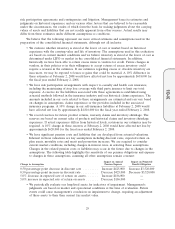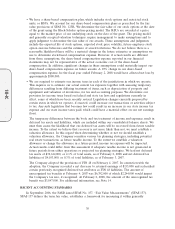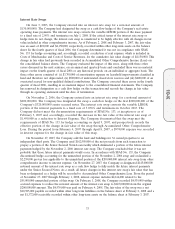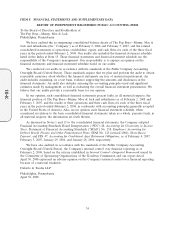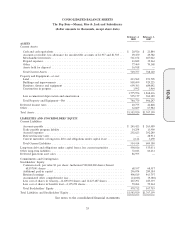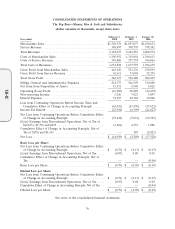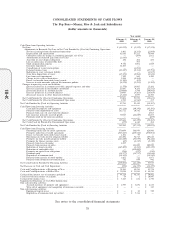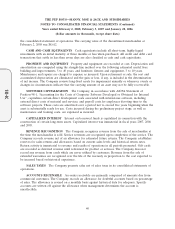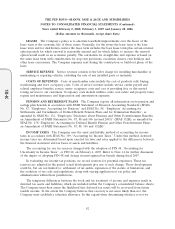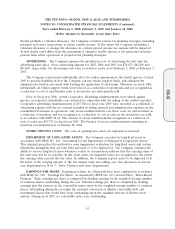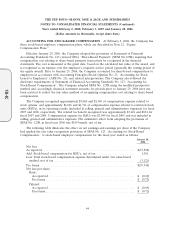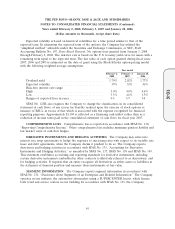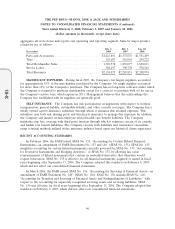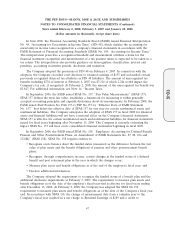Pep Boys 2007 Annual Report Download - page 85
Download and view the complete annual report
Please find page 85 of the 2007 Pep Boys annual report below. You can navigate through the pages in the report by either clicking on the pages listed below, or by using the keyword search tool below to find specific information within the annual report.
THE PEP BOYS—MANNY, MOE & JACK AND SUBSIDIARIES
NOTES TO CONSOLIDATED FINANCIAL STATEMENTS
Years ended February 2, 2008, February 3, 2007 and January 28, 2006
(dollar amounts in thousands, except share data)
NOTE 1—SUMMARY OF SIGNIFICANT ACCOUNTING POLICIES
BUSINESS The Pep Boys—Manny, Moe & Jack and subsidiaries (the ‘‘Company’’) is engaged
principally in the retail sale of automotive parts and accessories, automotive maintenance and service
and the installation of parts through a chain of stores. The Company currently operates stores in 35
states and Puerto Rico.
FISCAL YEAR END The Company’s fiscal year ends on the Saturday nearest to January 31.
Fiscal year 2007, which ended February 2, 2008, was comprised of 52 weeks, fiscal year 2006, which
ended February 3, 2007, was comprised of 53 weeks and fiscal year 2005, which ended January 28,
2006, was comprised of 52 weeks.
PRINCIPLES OF CONSOLIDATION The consolidated financial statements include the accounts
of the Company and its wholly owned subsidiaries. All intercompany balances and transactions have
been eliminated.
USE OF ESTIMATES The preparation of the Company’s consolidated financial statements in
conformity with accounting principles generally accepted in the United States of America necessarily
requires management to make estimates and assumptions that affect the reported amounts of assets
and liabilities and disclosure of contingent assets and liabilities at the date of the consolidated financial
statements and the reported amounts of revenues and expenses during the reporting period. Actual
results could differ from those estimates.
MERCHANDISE INVENTORIES Merchandise inventories are valued at the lower of cost or
market. Cost is determined by using the last-in, first-out (LIFO) method. An actual valuation of
inventory under the LIFO method can be made only at the end of each fiscal year based on inventory
and costs at that time. Accordingly, interim LIFO calculations must be based on management’s
estimates of expected fiscal year-end inventory levels and costs. If the first-in, first-out (FIFO) method
of costing inventory had been used by the Company, inventory would have been $555,188 and $600,035
as of February 2, 2008 and February 3, 2007, respectively. During fiscal 2007 and 2006, the effect of
LIFO layer liquidations on gross profit was immaterial.
The Company also records valuation adjustments for potentially excess and obsolete inventories
based on current inventory levels, the historical analysis of product sales and current market conditions.
The nature of the Company’s inventory is such that the risk of obsolescence is minimal and excess
inventory has historically been returned to the Company’s vendors for credit. The Company records
those valuation adjustments when less than full credit is expected from a vendor or when market is
lower than recorded costs. The valuation adjustments are revised, if necessary, on a quarterly basis for
adequacy. The Company’s inventory is recorded net of valuation adjustments for these matters which
were $11,167 and $13,462 as of February 2, 2008 and February 3, 2007, respectively.
During the third quarter of fiscal 2007, the Company recorded a $32,803 inventory impairment for
the discontinuance and planned exit of certain non-core merchandise products adopted as one of the
initial steps in the Company’s five-year strategic plan. The impairment charge reduced the carrying
value of the discontinued merchandise from $74,080 to $41,277. The carrying value of the discontinued
merchandise will be evaluated quarterly as compared to the estimated sell through that was utilized in
determining the impairment. The inventory impairment was recorded in cost of merchandise sales on
39
10-K


